Compiled by: Jinse Finance
Catherine Wood, a well-known Wall Street investor, and her ARK Invest have released the "Big Ideas" report at the beginning of each year since 2017, which has always attracted much attention from the market.
For the Big Ideas reports of the previous two years, please refer to Jinse Finance's previous reports "Big Ideas 2023 Report Quick Look: Currency, Finance and Internet Revolutions Are at a Turning Point" and "Big Ideas 2024 Report Crypto Section Overview: How Institutional Allocation Will Affect BTC".
ARK Invest released on February 4, 2025“Big Ideas 2025” report, the report is 148 pages long and has 12 parts.
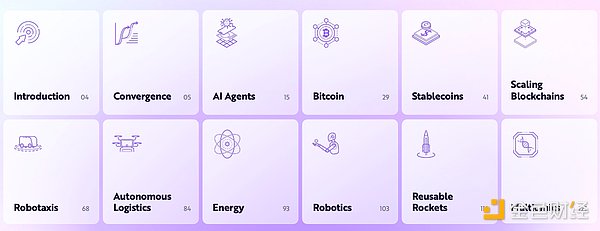
There are 4 cryptographic issues involved, namely: AI agents, Bitcoin, stablecoins and extended blockchains.
Jinse Finance has sorted out these 4 parts to reward readers.
1. AI agents: redefining consumer interactions and business workflows
What are AI agents?
AI agents are expected to accelerate the adoption of digital applications and bring about an epoch-making shift in human-computer interaction.
Understanding intent: Understanding user intent through natural language.
Planning Actions: Using reasoning and relevant context to plan.
Take Actions: Taking actions with the help of tools to achieve intent.
Continuous Learning: Continuously improving through iteration and continuous learning.
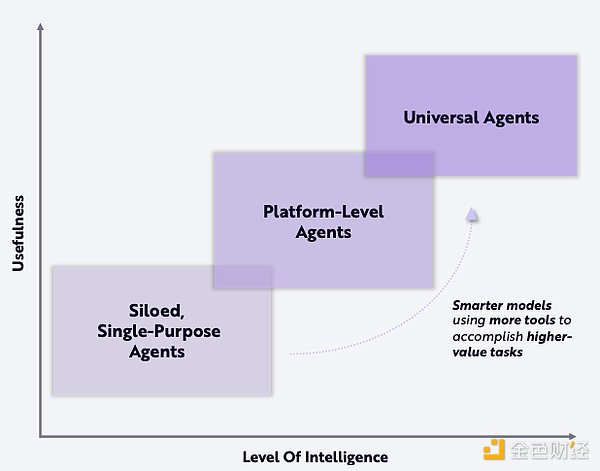
AI is accelerating the adoption of hardware and software
OpenAI could exceed $10 billion in revenue in 2025, becoming profitable faster than social media companies in the past decade. Using the adoption of ChatGPT as an indicator, AI will drive rapid demand for a range of new technologies.
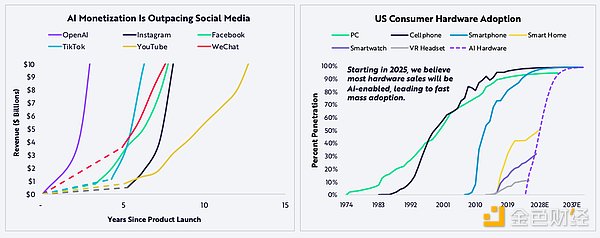
AI agents will change the way consumers search and discover
AI agents are embedded in the operating system of consumer hardware, allowing consumers to hand over all search and research work to AI, which greatly saves time. The screened AI results will provide context for digital advertising displays. If search shifts to personal AI agents, AI-mediated advertising revenues may soar significantly. By 2030, AI advertising revenues are expected to account for more than 54% of the $1.1 trillion digital advertising market.
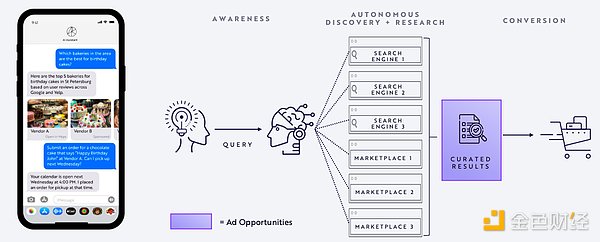 AI-mediated advertising should account for the largest share of digital ad revenue by 2030
AI-mediated advertising should account for the largest share of digital ad revenue by 2030
If search shifts to personal AI agents, AI-mediated ad revenue could surge significantly. We believe that by 2030, AI ad revenue could account for more than 54% of the $1.1 trillion digital ad market.
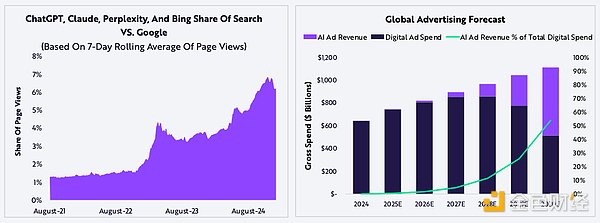 By 2030, AI-mediated shopping could approach 25% of global reachable online sales
By 2030, AI-mediated shopping could approach 25% of global reachable online sales
The increasing use of AI agents in consumer shopping will simplify product discovery, personalized recommendations, and purchase processes. ARK's research shows that by 2030, AI agents could facilitate nearly $9 trillion in online spending worldwide.
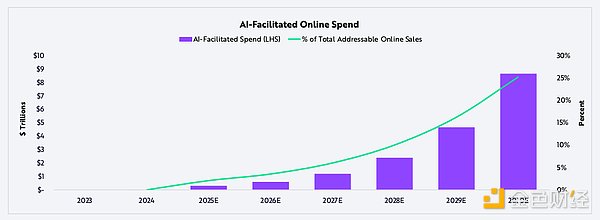 Digital wallets’ market share in e-commerce is expected to continue to grow
Digital wallets’ market share in e-commerce is expected to continue to grow
ARK’s research shows that digital wallets powered by AI purchasing agents (which are taking market share from payment methods such as credit and debit cards) could account for 72% of all e-commerce transactions by 2030.
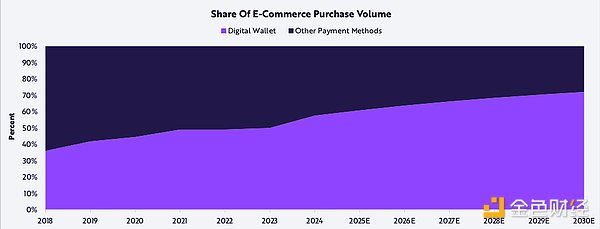
Digital wallets are integrating financial services and e-commerce
Based on their consumer-facing businesses, the market currently values leading digital wallet platforms such as Block, Robinhood, and SoFi at $1,800 per user. Digital wallet purchasing agents may become the core of the shopping journey, and "one-click checkout" will give way to "one-click query purchase".
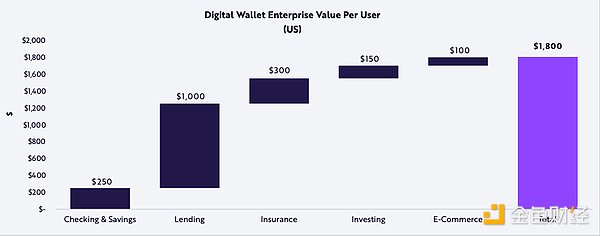 Digital wallet shopping agents may become the core of the shopping journey
Digital wallet shopping agents may become the core of the shopping journey
Agentic lead generation driven by agents should drive digital wallets to the upstream of the industry chain to seize market share in the global e-commerce and digital consumption fields. "One-click checkout" will gradually be replaced by "one-click query purchase".
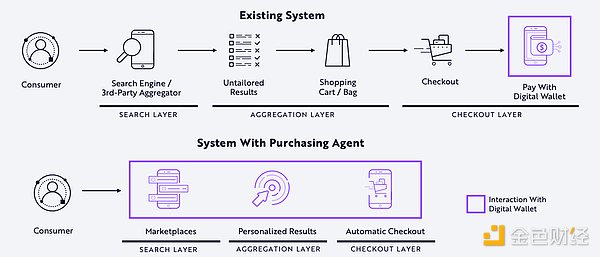
Purchasing Agents Will Increase the Enterprise Value of Digital Wallets, Especially in E-Commerce
Based on the charge rate for lead generation, AI purchasing agents could generate $4 billion to $20 billion in global revenue for digital wallet platforms in 2030 (ARK’s base and bullish case forecasts, respectively). By 2030, AI-driven purchasing agents could increase the enterprise value of US digital wallets by $50 to $200 per user.
 In the enterprise, AI agents will improve productivity through software
In the enterprise, AI agents will improve productivity through software
Companies that deploy AI agents should be able to increase output without increasing the workforce, and/or optimize the workforce for higher-value activities. As AI advances, agents may take on a higher proportion of the workload and complete higher-value tasks independently.
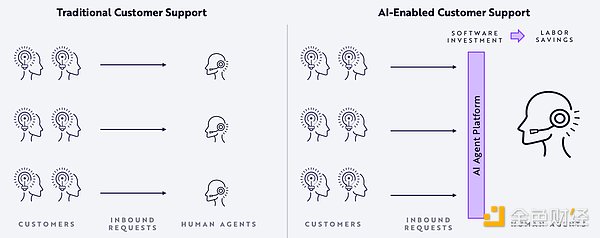 The decline in AI costs will significantly affect the economic benefits of agents
The decline in AI costs will significantly affect the economic benefits of agents
New products from OpenAI and Salesforce are cost-effectively supplementing the work of human customer service representatives. Even at a fixed cost of $1 per conversation, once AI agents can handle 35% of customer service inquiries, it can save companies a lot of money. AI agents should also reduce onboarding and recruitment costs, as well as seat-based software costs, and be easier to scale than human labor.

AI is reshaping the software value chain
The coding skills of AI agents are rapidly improving, accelerating the software development cycle. As the cost of creating software decreases, software production should accelerate and influence enterprises' "build or buy" decisions, replacing traditional software companies that are slow to adapt. As client software becomes popular, growth at all layers of the software stack should accelerate, although share will shift to the platform layer.
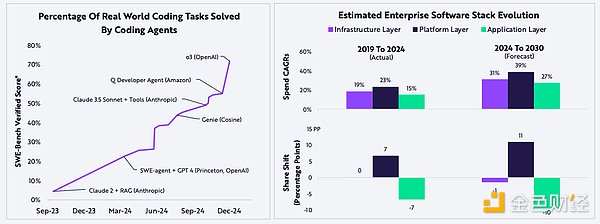 AI will help knowledge work take off
AI will help knowledge work take off
AI is driving a "Cambrian Explosion" in the software field. By 2030, the amount of software deployed per knowledge worker is expected to grow significantly as companies invest in solutions to improve productivity. Depending on the adoption rate, global software spending may accelerate from an annual growth rate of 14% in the past decade to 18% - 48%.
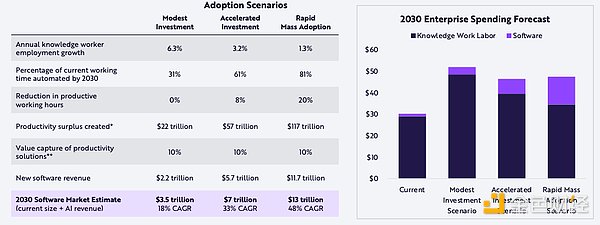
2. Bitcoin
A maturing global monetary system with a robust network foundation and rising institutional adoption
Bitcoin hits an all-time high in 2024
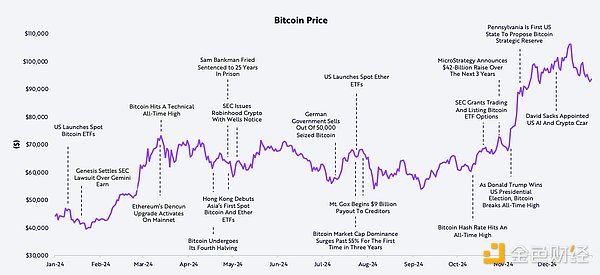 Spot Bitcoin ETF is the most successful ETF launch in history
Spot Bitcoin ETF is the most successful ETF launch in history
The Spot Bitcoin ETF attracted more than $4 billion in inflows on its first trading day, setting a new record for first-day inflows for ETF launches, surpassing the $1.2 billion in inflows for the first month of the Gold ETF launch in November 2004. The Spot Bitcoin ETF's inflows far exceed the inflows of any of the approximately 6,000 ETFs launched in the past 30 years in their first month of launch.
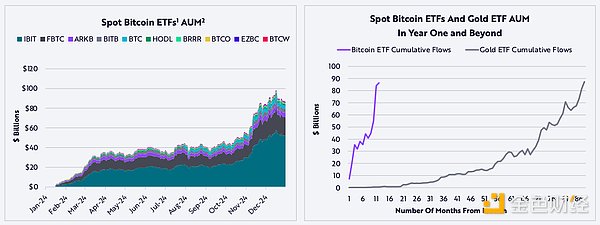
After the fourth halving, Bitcoin's inflation rate fell below the long-term supply growth rate of gold
Bitcoin's supply growth was "halved" for the fourth time in history, with the annual growth rate falling from about 1.8% to about 0.9%. The halving highlights Bitcoin's predictable monetary policy and its status as a scarce asset.
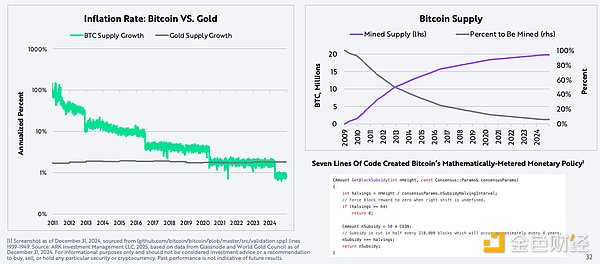 Bitcoin's annual volatility has fallen to a record low, while its risk-adjusted returns are still better than most major asset classes
Bitcoin's annual volatility has fallen to a record low, while its risk-adjusted returns are still better than most major asset classes
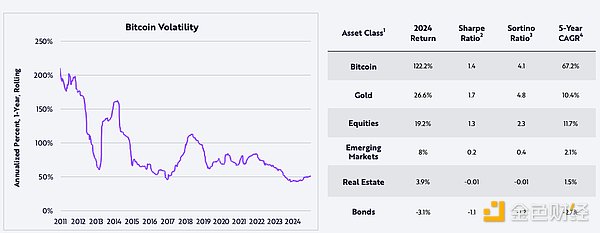 Bitcoin’s hash rate hits record high despite sharp drop in miner income after halving
Bitcoin’s hash rate hits record high despite sharp drop in miner income after halving
Even though the halving reduced Bitcoin miner income by 50%, its hash rate (a measure of network security) hit a record high. This shows that miners’ long-term confidence in Bitcoin remains strong.
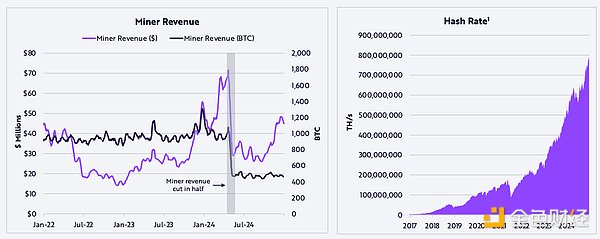
Bitcoin’s daily transaction count hits record high
Bitcoin’s daily transaction count hits a record high, thanks to the launch of the Runes protocol. The Runes protocol facilitates the creation of fungible tokens directly on the Bitcoin blockchain.
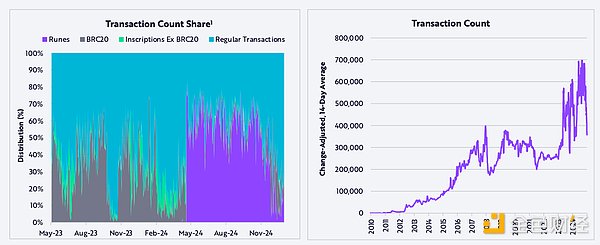
Bitcoin withstood significant selling pressure in 2024
In January 2024, the German government seized 50,000 Bitcoins associated with an online piracy organization and sold them six months later. The market successfully absorbed this supply, and the price of Bitcoin subsequently rose from $53,000 to $68,000. In addition, the much-anticipated mid-year repayment of Mt. Gox creditors distributed more than 109,000 Bitcoins, eliminating its biggest potential selling pressure.
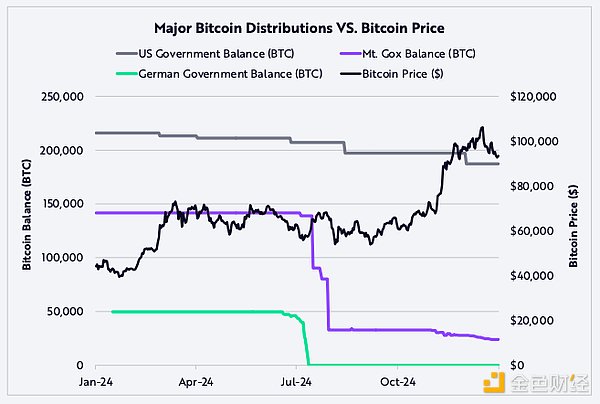 More and more listed companies hold Bitcoin
More and more listed companies hold Bitcoin
Currently, 74 listed companies hold Bitcoin on their balance sheets. The value of Bitcoin on corporate balance sheets has increased fivefold over the past year, from $1.1 billion in 2023 to $5.5 billion in 2024.
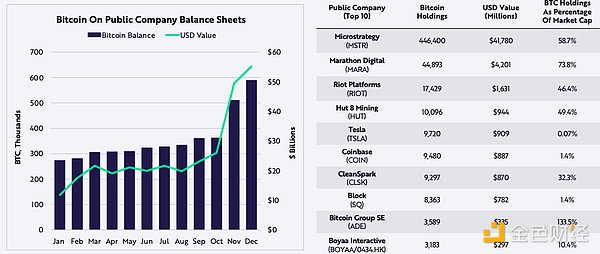
Bitcoin's total cost basis hit a new high in 2024
In 2024, Bitcoin's realized market value (i.e., cost basis) increased by 86%, and its average acquisition cost reached a record high of US$40,980 per coin, totaling US$811.7 billion.
 Bitcoin's transaction velocity and holding behavior highlight its role as a store of value
Bitcoin's transaction velocity and holding behavior highlight its role as a store of value
In 2024, Bitcoin's transaction velocity fell to a 14-year low, while the supply of Bitcoin held for three years or more reached an all-time high.
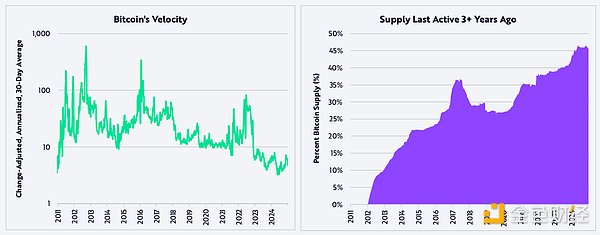 Bitcoin is expected to reach our predicted 2030 price target (lowest case $300,000, average case $710,000 and highest case $1.5 million)
Bitcoin is expected to reach our predicted 2030 price target (lowest case $300,000, average case $710,000 and highest case $1.5 million)

3. Stablecoins: Reshaping the digital asset sector
One of the fastest growing segments in the digital asset sector, stablecoins will surpass Mastercard and Visa in total transaction value in 2024
After two years of a bear market, with its market value falling by more than 70%, the development of stablecoins remains unabated. In 2024, the annualized transaction value of stablecoins will reach 15.6 trillion US dollars, which is about 119% and 200% of Visa and Mastercard respectively. The number of transactions per month will reach 110 million, which is about 0.41% and 0.72% of the number of transactions processed by Visa and Mastercard. This means that the value of each stablecoin transaction is much higher than Visa and Mastercard.
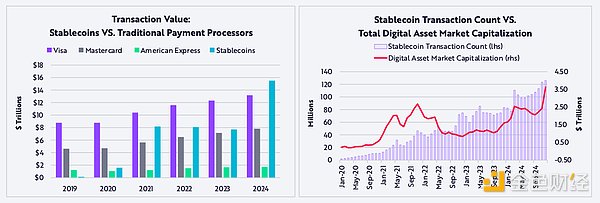
Stablecoin transaction volume hits a record high in December 2024
In December 2024, stablecoin transaction volume reached a new high. Solana, Tron, Ethereum, and Base are the main blockchains driving stablecoin transaction volume in 2024. In that month, the daily transaction volume of stablecoins reached 27 billion US dollars, and the monthly transaction volume reached 2.7 trillion US dollars, fully demonstrating the rapid development of this field.
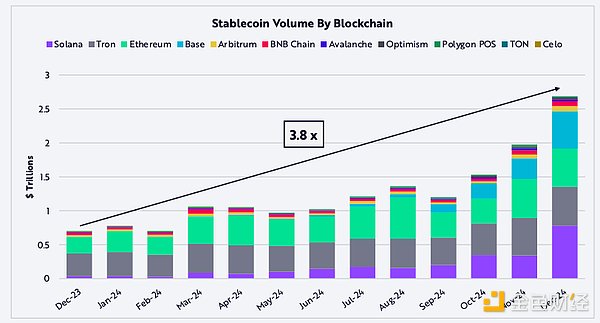
Ethena Labs tokenizes popular niche transactions, accumulating $6 billion in 12 months
Innovation in the stablecoin space is active, and Ethena Labs is one of the fastest growing projects. Although its novel design has been controversial, the project has captured a significant share of the non-fiat-backed stablecoin market, becoming a serious competitor in this $20 billion market. By tokenizing delta-neutral positions, Ethena Labs can provide a yield of up to 20%-30% depending on market conditions, although the yield may be negative in a bear market. In its first 12 months, its total locked value reached $6 billion, and it now accounts for 10% of Ethereum's total open interest, and is expanding delta-neutral trading on Solana and Bitcoin.
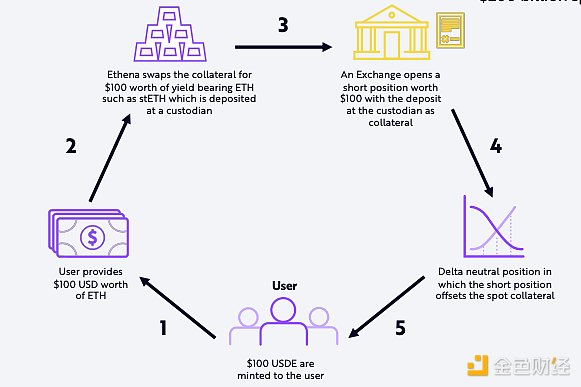
After shrinking in 2023, stablecoin supply and active addresses hit a record high in 2024
USDT dominates the stablecoin market, followed by USDC (Circle's stablecoin), which together account for 90% of the total supply. Stablecoins have a "multi-chain" nature and have penetrated almost every major first-layer blockchain. The total supply of stablecoins is $203 billion, accounting for about 0.97% of the U.S. M2 money supply. In December 2024, the number of active stablecoin addresses reached 23 million, a record high. The Tron network leads in terms of monthly active addresses and is favored in emerging markets for its low transaction fees.
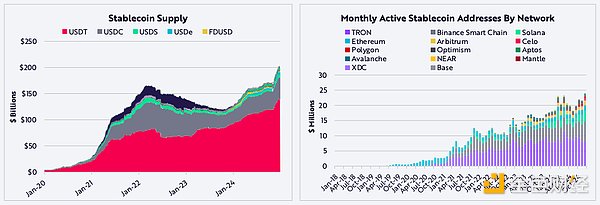 As some countries reduce their holdings of US dollars, digital assets are moving closer to the US dollar
As some countries reduce their holdings of US dollars, digital assets are moving closer to the US dollar
The digital asset field is experiencing "stablecoinization" and "dollarization". At the same time, China and Japan sold off a large number of U.S. Treasuries, Saudi Arabia ended the 45-year petrodollar agreement, and the BRICS countries reduced their reliance on US dollar payments by bypassing the SWIFT network. In the past, Bitcoin and Ethereum were the main bridges into the digital asset ecosystem, but in the past two years, stablecoins have taken their place and currently account for 35%-50% of total on-chain transactions. Stablecoins pegged to the US dollar dominate, accounting for more than 98% of the supply, followed by gold-backed and euro-backed stablecoins, accounting for about 1% and 0.5%, respectively. ARK's research shows that Asian currency-backed stablecoins will also appear in the market in the future.

Stablecoins attract retail investors, thanks to the low cost and high efficiency of Layer 2
Retail investors have flocked to the field due to the lower cost and more convenient stablecoin transactions provided by Layer 2, which has increased the market share of blockchains such as Arbitrum, Base and Optimism. However, large investors and institutions still mainly trade on the Ethereum mainnet. Transactions below $100 on Base and Optimism are dominant, while transactions above $100 on the Ethereum mainnet are dominant.

Peer-to-peer transactions and personal wallet storage dominate stablecoin usage scenarios
In the use of stablecoins, externally owned accounts (EOAs), which are standard Ethereum addresses used for peer-to-peer (P2P) transactions and storage, account for 60% of USDC usage, while centralized exchanges account for 11%, bridges across Layer 2 solutions account for 7%, and decentralized exchanges (DEXs) and money markets each account for 1.7%. As the use of decentralized finance (DeFi) surges in the coming years, DEXs, bridges, and money markets may take back market share from P2P transactions. However, due to product-market fit, P2P trading and storage are more resilient in scenarios other than trading, and their usage fluctuates less with market cycles.
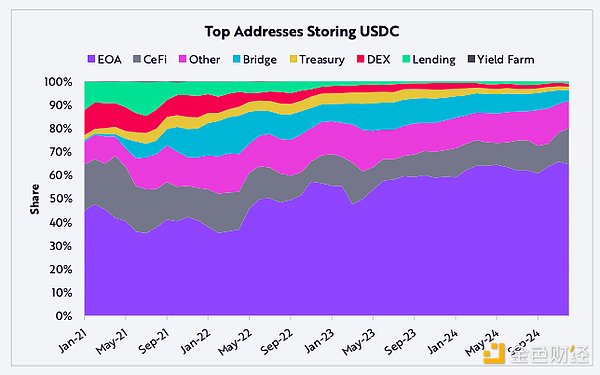
Four stablecoin issuers dominate revenue in the digital asset space
In terms of revenue in the digital asset space, a handful of stablecoin issuers dominate. Tether (USDT) and Circle (USDC) account for 60% of the revenue generated by the top five networks and applications. In the second half of 2024, stablecoins such as USDT, USDC, DAI/USDS, and USDE generated a total of $3.35 billion in revenue, an annualized revenue of $6.7 billion. Among them, Tether, which has fewer than 200 employees, reported a profit of $5.2 billion in the first half of 2024, covering USDT and other products and services, as well as unrealized gains on digital assets, making it one of the most capital-efficient companies in history.
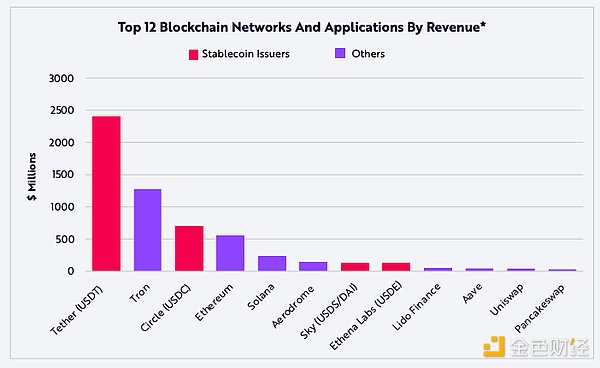
Tether's financial performance is amazing
Tether has fewer than 200 employees, compared to JPMorgan Chase and Berkshire Hathaway, which each have more than 300,000 employees. In the first half of 2024, in the S&P Financial Select Industry Index, the only institutions with net income exceeding Tether were Berkshire Hathaway, JPMorgan Chase, Bank of America, and Wells Fargo.
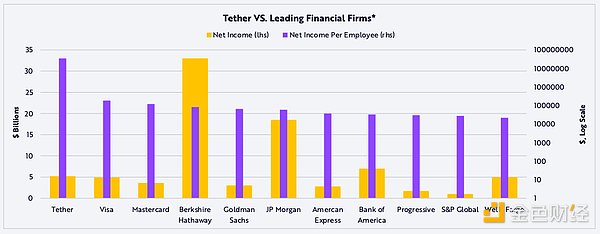
Stablecoins increase demand for U.S. Treasuries
Amid the global trend of deglobalization and de-dollarization, stablecoins may drive stable demand for U.S. Treasuries. As of December 2024, Tether and Circle have become the 20th largest holders of U.S. Treasuries. In populous emerging markets such as Brazil, Nigeria, Turkey, Indonesia, and India, individuals and businesses use stablecoins as a means of value storage, payment method, and cross-border currency, and stablecoins may become an effective way to export dollars.
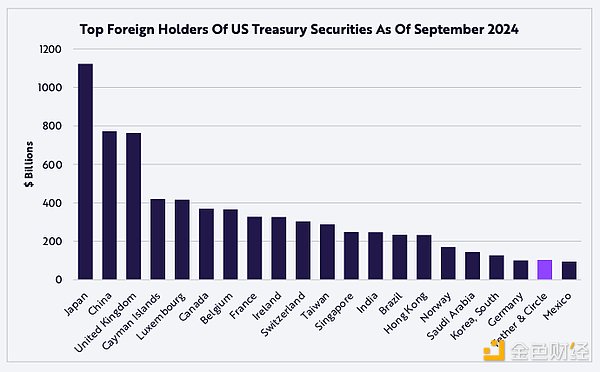
Stablecoin issuers transfer risk-free interest income to users
Circle and Tether have earned billions of dollars in revenue from U.S. Treasuries and other securities used as collateral for stablecoins. However, in 2024, affected by competition and market demand, stablecoins operating outside the United States began to return most of their interest income to users. Although Circle and Tether are unlikely to follow this trend immediately, interest-bearing stablecoins have become the fastest growing category in the stablecoin market.
 By 2030, the scale of stablecoins may grow significantly, from 0.17% of the global M2 supply to 0.9%
By 2030, the scale of stablecoins may grow significantly, from 0.17% of the global M2 supply to 0.9%
The current supply of stablecoins is $203 billion, accounting for 0.17% of the global M2 supply. It is expected that by 2030, its supply may grow to $1.4 trillion, accounting for 0.9%. If so, stablecoins will become the 13th largest currency in circulation in the world, ranking after the Spanish currency and before the Dutch currency.
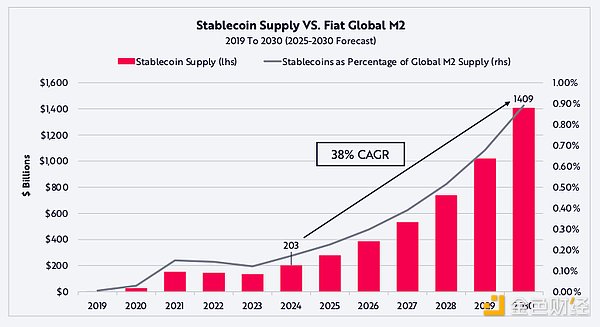
Fourth, blockchain expansion: achieving significant cost reduction and opening new use cases at the application layer
Smart contract map navigation
As the digital asset field becomes increasingly complex, smart contracts are driving innovation in more and more industries. From user-centric games and SocialFi applications, to advanced financial instruments such as derivatives and structured products, to decentralized infrastructure networks that power wireless connectivity and energy storage, the relevant ecosystem is rapidly developing to meet diverse and dynamic needs.
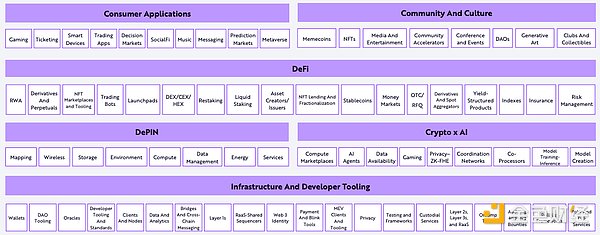 In pursuit of lower fees and higher efficiency, applications are either deployed on the high-throughput first-layer blockchain Solana or on Ethereum's second-layer expansion solution
In pursuit of lower fees and higher efficiency, applications are either deployed on the high-throughput first-layer blockchain Solana or on Ethereum's second-layer expansion solution
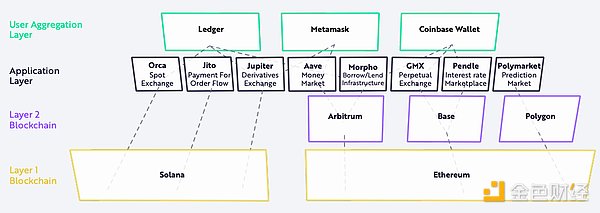
Ethereum EIP 4844 Upgrade Reduces Transaction Fees 10 Times
Ethereum's EIP 4844 upgrade is one of its most important technical upgrades to date, enabling faster and cheaper transactions on the second layer network, reducing transaction costs by 10 times and stimulating the use of related applications. The EIP 4844 upgrade is a major milestone in the Ethereum roadmap, and is expected to increase transactions per second (TPS) by 250 to 1,250 times from the current approximately 400 transactions to 100,000-500,000 transactions. To date, more than 200 second-layer projects have been launched, and more are in the works.
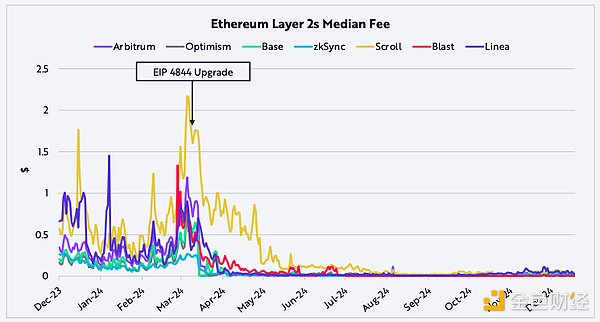
The decline in transaction costs drives the development of Layer 2
The sharp decline in transaction costs has led to a significant increase in the activity of Layer 2, attracting a large number of users to transfer from the Ethereum mainnet. Layer 2 accounts for 85% of the daily active addresses conducting transactions in the Ethereum ecosystem. In 2024, Layer 2 activities increased the number of daily transactions on Ethereum by 400%, from 3 million to 15 million.
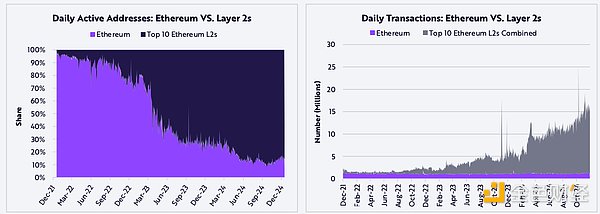 Base becomes the fastest growing Ethereum Layer 2 blockchain
Base becomes the fastest growing Ethereum Layer 2 blockchain
Base has surpassed all other Ethereum Layer 2 solutions in terms of growth rate and market share within a year of its launch. In 2024, Base accounted for 46% of Ethereum Layer 2's active users and 63% of the fees generated. Its total locked value reached US$15 billion, with more than 300 deployed applications, making an important contribution to Coinbase's cash flow.
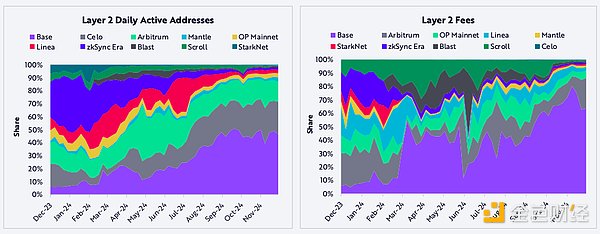
Even though many transactions have migrated to Layer 2, Ethereum Mainnet still dominates high-value storage and settlement
Institutions, high-value users, and large cryptocurrency holders mainly settle transactions on Ethereum Mainnet. The unit economic benefits of Ethereum Mainnet are unparalleled, measured by total locked value (TVL) and decentralized exchange (DEX) per-user transaction volume.
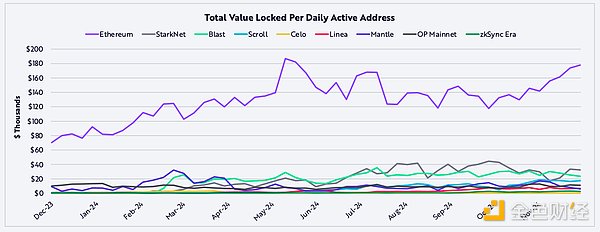 As DeFi soars to all-time highs, DEXs challenge centralized trading venues in both spot and derivatives trading
As DeFi soars to all-time highs, DEXs challenge centralized trading venues in both spot and derivatives trading
When Binance reached a settlement of more than $4 billion with the U.S. Securities and Exchange Commission (SEC) in 2024 and its CEO resigned, some of the market share of centralized exchanges (CEXs) was taken away by decentralized exchanges (DEXs) From January to the peak, the spot and derivatives trading volumes of decentralized finance (DeFi) almost doubled, with market shares increasing from 8% and 3% to 14% and 8%, respectively, reaching all-time highs. During this period, Binance’s market share among centralized exchanges fell from 62% to 35%.
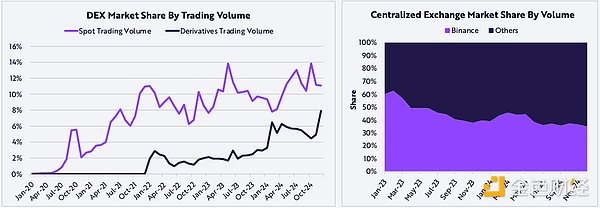 Exchanges driven by smart contracts are 5 to 10 times more efficient than their centralized counterparts
Exchanges driven by smart contracts are 5 to 10 times more efficient than their centralized counterparts
Decentralized exchanges like Uniswap, Aerodrome, and Raydium leverage the efficiency of small and agile teams to develop and maintain core protocol infrastructure. They have a huge efficiency advantage over centralized exchanges, with only one-tenth the number of employees. Binance has the largest number of employees in the centralized exchange field, with about 9,000 employees.
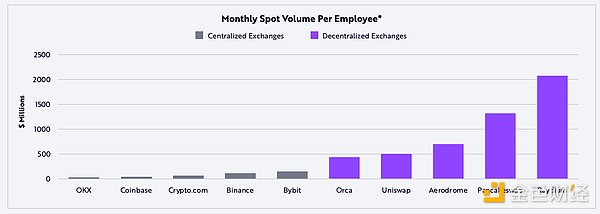
Liquid Staking and Restaking Protocols Are the Preferred Solutions for Staking and Restaking ETH
Liquid staking and restaking have become the preferred method for generating yield on Ethereum. Due to their interest-bearing properties, liquidity, and accessibility, they now account for 40% of Ethereum staked. The demand to restake staked Ethereum to increase yield has given rise to restaking platforms, which currently hold about 5.5 million Ethereum, accounting for 17% of staked Ethereum.
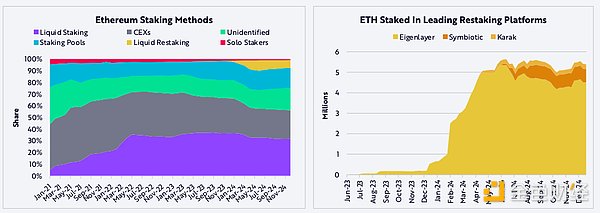
Led by Polymarket, prediction markets become a breakthrough consumer application in 2024
In 2024, Polymarket accumulated more than 3 million users and reached $1.2 billion in monthly trading volume, with elections and political activities driving 70% of its business. After a brief pullback after the election, its daily unique users have recovered to 50,000, and trading volume has also rebounded as sports events have become the most important category.
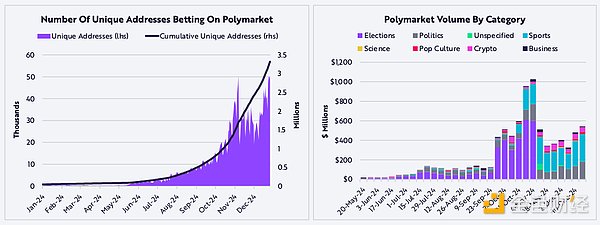
Solana has higher throughput than Ethereum, thanks to its high-performance design and strategic trade-offs
Ethereum’s throughput has more than doubled to about 200 transactions per second (TPS), thanks to the second layer network and EIP 4844 upgrade. Despite this, Solana still performs better, with an average throughput of about 800 TPS. Solana’s success is based on a series of trade-offs, including more expensive hardware requirements and parallel transaction processing. Solana’s new Firedancer client may increase its throughput to hundreds of thousands of TPS.

Solana Gains Market Share on Multiple Metrics Thanks to Retail Adoption
After falling to a bear market low of $8 in 2023, Solana has made a significant turnaround relative to other first-layer networks. Its daily active users, revenue, number of transactions, and total value locked (TVL) have reached all-time highs or increased by an order of magnitude. Solana is the only first-layer network that competes with Ethereum and Bitcoin on metrics such as daily active addresses and revenue.
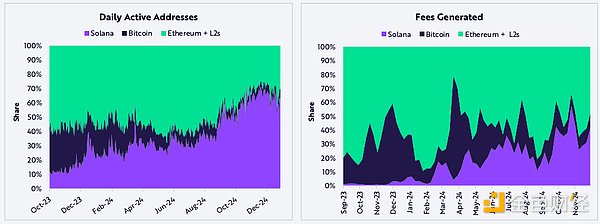
Solana and Base Lead in Developer Adoption and Attention
In 2024, Solana led with 7,625 developers among the 39,139 new crypto developers, surpassing the Ethereum mainnet. Base has a total of 4,287 developers, ranking sixth in the overall ranking, surpassing Arbitrum and Starknet to become Ethereum's leading second-layer solution.
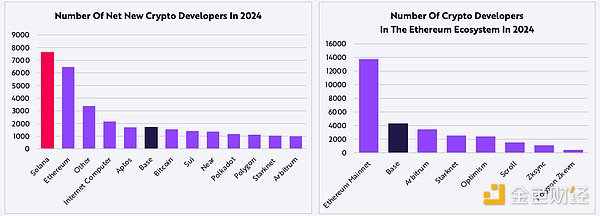
 Weatherly
Weatherly




 AI-mediated advertising should account for the largest share of digital ad revenue by 2030
AI-mediated advertising should account for the largest share of digital ad revenue by 2030 By 2030, AI-mediated shopping could approach 25% of global reachable online sales
By 2030, AI-mediated shopping could approach 25% of global reachable online sales Digital wallets’ market share in e-commerce is expected to continue to grow
Digital wallets’ market share in e-commerce is expected to continue to grow
 Digital wallet shopping agents may become the core of the shopping journey
Digital wallet shopping agents may become the core of the shopping journey
 In the enterprise, AI agents will improve productivity through software
In the enterprise, AI agents will improve productivity through software The decline in AI costs will significantly affect the economic benefits of agents
The decline in AI costs will significantly affect the economic benefits of agents
 AI will help knowledge work take off
AI will help knowledge work take off
 Spot Bitcoin ETF is the most successful ETF launch in history
Spot Bitcoin ETF is the most successful ETF launch in history
 Bitcoin's annual volatility has fallen to a record low, while its risk-adjusted returns are still better than most major asset classes
Bitcoin's annual volatility has fallen to a record low, while its risk-adjusted returns are still better than most major asset classes Bitcoin’s hash rate hits record high despite sharp drop in miner income after halving
Bitcoin’s hash rate hits record high despite sharp drop in miner income after halving

 More and more listed companies hold Bitcoin
More and more listed companies hold Bitcoin
 Bitcoin's transaction velocity and holding behavior highlight its role as a store of value
Bitcoin's transaction velocity and holding behavior highlight its role as a store of value




 As some countries reduce their holdings of US dollars, digital assets are moving closer to the US dollar
As some countries reduce their holdings of US dollars, digital assets are moving closer to the US dollar





 By 2030, the scale of stablecoins may grow significantly, from 0.17% of the global M2 supply to 0.9%
By 2030, the scale of stablecoins may grow significantly, from 0.17% of the global M2 supply to 0.9%
 In pursuit of lower fees and higher efficiency, applications are either deployed on the high-throughput first-layer blockchain Solana or on Ethereum's second-layer expansion solution
In pursuit of lower fees and higher efficiency, applications are either deployed on the high-throughput first-layer blockchain Solana or on Ethereum's second-layer expansion solution

 Base becomes the fastest growing Ethereum Layer 2 blockchain
Base becomes the fastest growing Ethereum Layer 2 blockchain
 As DeFi soars to all-time highs, DEXs challenge centralized trading venues in both spot and derivatives trading
As DeFi soars to all-time highs, DEXs challenge centralized trading venues in both spot and derivatives trading Exchanges driven by smart contracts are 5 to 10 times more efficient than their centralized counterparts
Exchanges driven by smart contracts are 5 to 10 times more efficient than their centralized counterparts








